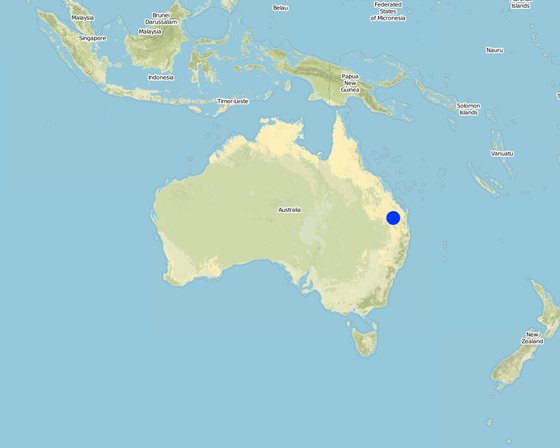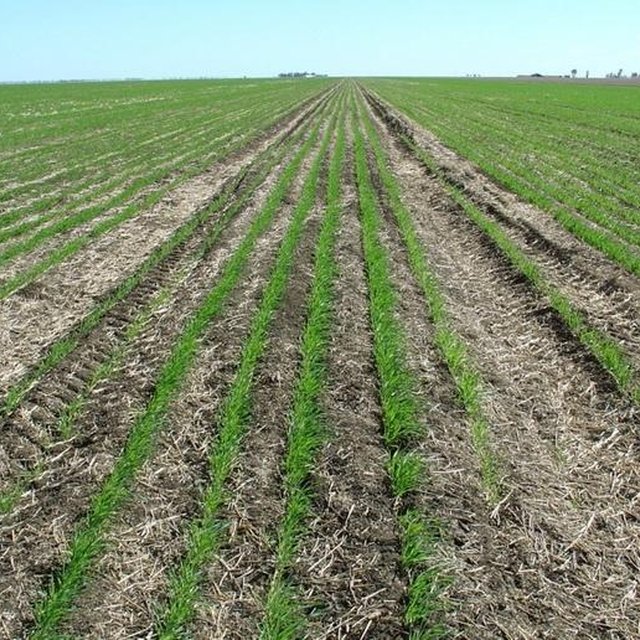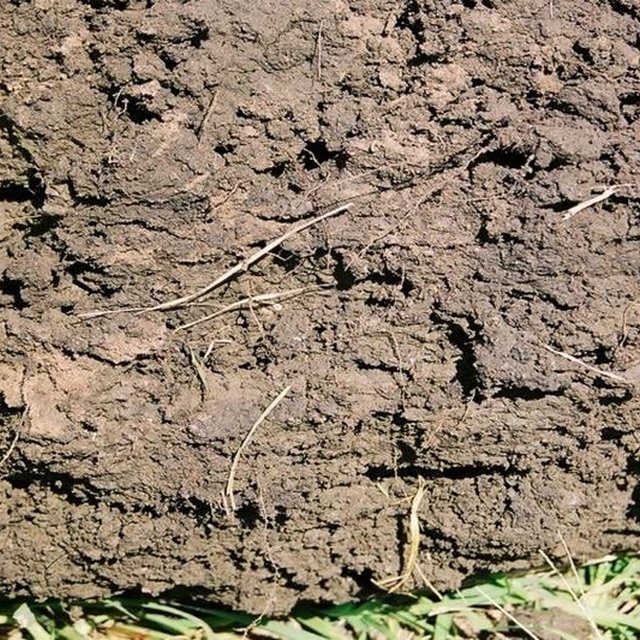No-till with controlled traffic
(澳大利亚)
no-till, permanent uncropped wheel tracks,eliminate soil compaction, judiciois spraying
描述
Large-scale no-till grain production with permanent wheel tracks
common to all on-farm equipment.
This controlled traffic, no-till farming system (CT/NT) is practiced on a 1,900 ha farm on the broad, almost flat Jandowae Plains in semi-arid Queensland, Australia. Principal soil types are vertisols, with some poorer areas where the sand content is greater, and these have a tendency to hard-set and crust. Over the past five years, the farm owner has changed the farming system completely from conventional farming to no-till with controlled traffic. Controlled traffic means permanent uncropped wheel tracks or ‘tramlines’: all equipment has 2 metre axles. The total farm machinery comprises a tractor, a spray rig and two 11 meter zero-till planter/fertilizer units; one each for wheat and sorghum sowing. The tramlines were laid out two years ago by a contractor using Geographical Positioning System (GPS).
The main technical objective was to eliminate soil compaction. The CT/NT combination ensures the land -between the tramlines - remains in excellent condition. There has been no ploughing or tillage at all in those 5 years. He practices a three year rotation between winter wheat, summer sorghum and fallow, but the system is not fixed: it depends very much on soil moisture status and thus on the rainfall (opportunity cropping). Generally in summer about one third is in summer sorghum and in winter about one third in winter wheat, the rest of the land is
under fallow. The one-year fallow is maintained through the use of herbicides sprayed onto the undisturbed residue from the previous crop. The system is designed for rain capture - to build up soil moisture stores in the fallow periods for subsequent crops - and for disease control (to ‘spell’ the land). During the cropping cycle, the key to his effective weed control system is ‘to get in early’ and ‘actively chase weeds’ through judicious spraying. The farm is now free of the locally common persistent weed Erigeron annuus. In the five years his sorghum yields have risen from 3 to 7 tons per hectares. Over the last three years the soil has improved, becoming soft, friable and moist between his plant lines. Infiltration has improved a lot and soil structure is now excellent.
Tractor use and overall fuel consumption has decreased to less than one quarter of that under conventional tillage. Correspondingly the workload is hugely reduced: from four men required under the conventional system for an equivalent area, the farmer is the sole operator, very occasionally assisted by his son, and a paid contractor for harvesting. He is so satisfied with the CT/NT system that he is attempting to purchase a nearby property to extend the area that he can farm using his current machinery.
地点

地点: Jimbour (north of Dalby), Queensland, 澳大利亚
分析的技术场所数量:
技术传播: 均匀地分布在一个区域 (19.0 km²)
在永久保护区?:
实施日期:
介绍类型
-
通过土地使用者的创新
-
作为传统系统的一部分(> 50 年)
-
在实验/研究期间
-
通过项目/外部干预

A view of a set of tramlines in the previous winter’s wheat stubble. Spacing is 2 m between the two permanent wheel tracks and 10 m between two sets of tramlines (visible to the left and right). (Hanspeter Liniger)

soil profile (0–30 cm depth): from the sorghum ‘bed’ with excellent, crumb and small blocky structure, with abundant root growth (Des McGarry)
主要目的
-
改良生产
-
减少、预防、恢复土地退化
-
保护生态系统
-
结合其他技术保护流域/下游区域
-
保持/提高生物多样性
-
降低灾害风险
-
适应气候变化/极端天气及其影响
-
减缓气候变化及其影响
-
创造有益的经济影响
-
创造有益的社会影响
土地利用
同一土地单元内混合使用的土地: 否
-
农田
- 一年一作: 谷类 - 高粱, 谷类 - 小麦(冬季)
每年的生长季节数: 2
采用间作制度了吗?: 否
采用轮作制度了吗?: 是
供水
土地退化相关的目的
-
防止土地退化
-
减少土地退化
-
修复/恢复严重退化的土地
-
适应土地退化
-
不适用
解决的退化问题
-
土壤水蚀 - Wt:表土流失/地表侵蚀 , Wg:冲沟侵蚀/沟蚀
SLM措施
-
农艺措施 - A3:土壤表面处理 (A 3.1:免耕)
技术建立与维护:活动、投入和费用
投入和成本的计算
- 计算的成本为:
- 成本计算使用的货币:美元
- 汇率(换算为美元):1 美元 = 不适用
- 雇用劳工的每日平均工资成本:160
影响成本的最重要因素
In average one third of the farm area is in crop and two thirds are fallow. This means that overall farming costs per
ha are reduced, since during fallow period activities are limited to spraying herbicides. Labour costs approximately US$ 160 per day. Machinery costs average out at US$ 20 per hour (diesel costs US$ 0.9 per litre). All the data comes from this single farmer. Purchase of equipment is not included in the table above.
技术建立活动
-
layout of the controlled traffic lines (tramlines) using GPS mounted in a 4x4 vehicle. Two days were adequate for the whole farm. (时间/频率: None)
技术建立的投入和成本
| 对投入进行具体说明 |
单位 |
数量 |
单位成本 (美元) |
每项投入的总成本 (美元) |
土地使用者承担的成本% |
|
劳动力
|
| Labour |
ha |
1.0 |
5.0 |
5.0 |
100.0 |
| 技术建立所需总成本 |
5.0 |
|
| 技术建立总成本,美元 |
5.0 |
|
技术维护活动
-
Layout of the controlled traffic lines (tramlines) (时间/频率: Two days were adequate for the establishment on the whole farm.)
-
Weed control (spray-coupe) with roundup (时间/频率: Summer sorghum (650 ha, during 1 season or half a year))
-
Fertilizing (时间/频率: Summer sorghum (650 ha, during 1 season or half a year))
-
Sowing and simultaneous application of starter fertilizer (时间/频率: Mid October, Summer sorghum (650 ha, during 1 season or half a year))
-
Spraying pre-emergent herbicide to kill summer grasses (时间/频率: Summer sorghum (650 ha, during 1 season or half a year))
-
Harvest by contractors (时间/频率: early March, Summer sorghum (650 ha, during 1 season or half a year))
-
Weed control (时间/频率: Winter wheat (650 ha, during 1 season or half a year))
-
Fertilizing (Urea) (时间/频率: Winter wheat (650 ha, during 1 season or half a year))
-
Sowing and simultaneous application of starter fertilizer (时间/频率: Mid May, Winter wheat (650 ha, during 1 season or half a year))
-
In-crop weed spray (时间/频率: Winter wheat (650 ha, during 1 season or half a year))
-
Harvest by contractors (时间/频率: October)
-
Fallow (1,250 ha) (时间/频率: During 2 seasons or totally 1 year)
-
Weed control (combination of roundup mixed with broadleaf herbicide) (时间/频率: 5–6 times per fallow period)
-
Determine the soil moisture (To determine soil moisture he uses an iron rod; if he can push it into the heavy clay soil, then the soil is moist. Additionally, he measures rainfall) (时间/频率: None)
技术维护的投入和成本
| 对投入进行具体说明 |
单位 |
数量 |
单位成本 (美元) |
每项投入的总成本 (美元) |
土地使用者承担的成本% |
|
劳动力
|
| Labour |
ha |
1.0 |
5.0 |
5.0 |
100.0 |
|
设备
|
| Animal traction |
ha |
1.0 |
6.0 |
6.0 |
100.0 |
| Harvesting by contractor |
ha |
1.0 |
17.0 |
17.0 |
100.0 |
|
植物材料
|
| Seeds |
ha |
1.0 |
8.0 |
8.0 |
100.0 |
|
肥料和杀菌剂
|
| Fertilizer |
ha |
1.0 |
53.0 |
53.0 |
100.0 |
| Biocides |
ha |
1.0 |
22.0 |
22.0 |
100.0 |
| 技术维护所需总成本 |
111.0 |
|
| 技术维护总成本,美元 |
111.0 |
|
自然环境
年平均降雨量
-
< 250毫米
-
251-500毫米
-
501-750毫米
-
751-1,000毫米
-
1,001-1,500毫米
-
1,501-2,000毫米
-
2,001-3,000毫米
-
3,001-4,000毫米
-
> 4,000毫米
关于气候的规范
Thermal climate class: subtropics
斜坡
-
水平(0-2%)
-
缓降(3-5%)
-
平缓(6-10%)
-
滚坡(11-15%)
-
崎岖(16-30%)
-
陡峭(31-60%)
-
非常陡峭(>60%)
海拔
-
0-100 m a.s.l.
-
101-500 m a.s.l.
-
501-1,000 m a.s.l.
-
1,001-1,500 m a.s.l.
-
1,501-2,000 m a.s.l.
-
2,001-2,500 m a.s.l.
-
2,501-3,000 m a.s.l.
-
3,001-4,000 m a.s.l.
-
> 4,000 m a.s.l.
土壤深度
-
非常浅(0-20厘米)
-
浅(21-50厘米)
-
中等深度(51-80厘米)
-
深(81-120厘米)
-
非常深(> 120厘米)
土壤质地(表土)
-
粗粒/轻(砂质)
-
中粒(壤土、粉土)
-
细粒/重质(粘土)
土壤质地(地表以下>20厘米)
-
粗粒/轻(砂质)
-
中粒(壤土、粉土)
-
细粒/重质(粘土)
水质(未处理)
-
良好饮用水
-
不良饮用水(需要处理)
-
仅供农业使用(灌溉)
-
不可用
应用该技术的土地使用者的特征
非农收入
-
低于全部收入的10%
-
收入的10-50%
-
> 收入的50%
个人或集体
-
个人/家庭
-
团体/社区
-
合作社
-
员工(公司、政府)
每户使用面积
-
< 0.5 公顷
-
0.5-1 公顷
-
1-2 公顷
-
2-5公顷
-
5-15公顷
-
15-50公顷
-
50-100公顷
-
100-500公顷
-
500-1,000公顷
-
1,000-10,000公顷
-
> 10,000公顷
土地所有权
-
州
-
公司
-
社区/村庄
-
团体
-
个人,未命名
-
个人,有命名
采用和适应
在所有采用这种技术的人当中,有多少人在没有获得物质奖励的情况下采用了这种技术?
-
0-10%
-
11-50%
-
51-90%
-
91-100%
户数和/或覆盖面积
200
最近是否对该技术进行了修改以适应不断变化的条件?
什么样的变化条件?
-
气候变化/极端气候
-
不断变化的市场
-
劳动力可用性(例如,由于迁移)
结论和吸取的教训
长处: 土地使用者的观点
长处: 编制者或其他关键资源人员的观点
-
Land that previously was un-farmable is now under crops. Site inspection shows initially poor land to be now in good condition (after only 5 years). The value of the land has increased
How can they be sustained / enhanced? Farmers practising CT/NT can and are buying/leasing more land, which will improve the overall state of the land in Queensland.
-
Farmers can manage much larger growing areas with less personnel and equipment. A single operator is well able to run a large arable farm on his own
How can they be sustained / enhanced? Ditto.
-
Cereal farming is now less prone to yield losses (and crop failure) in drought years – as there is better rainwater infiltration and water use efficiency with CT/NT
How can they be sustained / enhanced? Continue with the system.
-
He has all weeds under control (without need for tillage).
弱点/缺点/风险: 土地使用者的观点如何克服
弱点/缺点/风险: 编制者或其他关键资源人员的观点如何克服
-
The contract harvester runs on 3 m wide axles, so the wheels run on the beds. However, there has only been one wet harvest in 5 years so the incidence of soil compaction from harvesting is negligible
This is not really seen as a problem. One solution would be to build a dedicated harvester (too expensive) or find a contractor with equipment that fitted the system.
-
A conservative mentality towards conservation agriculture is constraining the adoption of the system by other farmers
Continue demonstrating and disseminating knowledge about benefits.
参考文献
审查者
-
Alexandra Gavilano
-
Fabian Ottiger
实施日期: Sept. 28, 2010
上次更新: Feb. 14, 2019
资源人
-
Des McGarry - SLM专业人员
-
Noel Griffith - SLM专业人员
文件编制者
机构
项目
- Book project: where the land is greener - Case Studies and Analysis of Soil and Water Conservation Initiatives Worldwide (where the land is greener)
主要参考文献
-
Blackwell P (1998) Customised controlled traffic farming systems, instead of standard recommendations or ‘tramlines ain’t tramlines’.In Second national controlled farming conference, pp. 23–26. Eds JN Tullberg and DF Yule.: Gatton College: University of Queensland
-
Hulme PJ, McKenzie DC, MacLeod DA and Anthony DTW (1996) An evaluation of controlled traffic with reduced tillage for irrigated cotton on a Vertisol.
Soil and Tillage Research 38:217–237:
-
McGarry D, Bridge BJ and Radford BJ (2000). Contrasting soil physical properties after zero and traditional tillage of an alluvial soil in the semi-arid tropics. Soil and Tillage Research 53:105–115:









